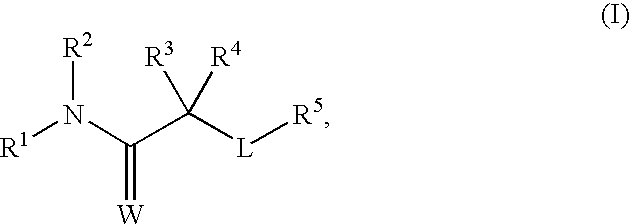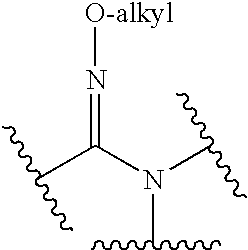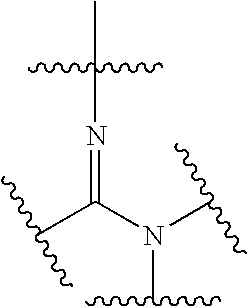[0435]Glucocorticoids are known to cause a variety of
skin related side effects including
skin thinning, and impairment of
wound healing (Anstead, Adv
Wound Care, 11, 277-85 (1998); Beer et al., Vitam Horm., 59, 217-39 (2000)). 11β-HSD1 is expressed in
human skin fibroblasts, and it has been shown that the
topical treatment with the non-selective 11β-HSD1 and 11β-HSD2 inhibitor glycerrhetinic acid increases the
potency of topically applied
hydrocortisone in a
skin vasoconstrictor
assay (Hammami, et al., J. Clin. Endocrinol. Metab., 73, 326-34 (1991)). Advantageous effects of selective 11β-HSD1 inhibitors on
wound healing have also been published (International Publication No. WO 2004 / 11310). It is therefore expected that potent, selective 11β-HSD1 inhibitors would treat
wound healing or skin
thinning due to excessive
glucocorticoid activity.
[0436]Excess glucocorticoids decrease
bone mineral density and increase
fracture risk. This effect is mainly mediated by inhibition of osteoblastic
bone formation, which results in a net bone loss (Kim et al., J. Endocrinol., 162, 371-379 (1999);
Bellows et al., Bone, 23, 119-125 (1998); Cooper et al., Bone, 27, 375-381 (2000)). Glucocorticoids are also known to increase
bone resorption and reduce
bone formation in mammals (Turner et al., Calcif. Tissue Int., 54, 311-5 (1995); Lane et al., Med. Pediatr. Oncol., 41, 212-6 (2003)). 11β-HSD1
mRNA expression and
reductase activity have been demonstrated in primary cultures of human osteoblasts in homogenates of
human bone (Bland et al., J. Endocrinol., 161, 455-464 (1999); Cooper et al., Bone, 23, 119-125 (2000); Cooper et al., J. Bone Miner. Res., 17, 979-986 (2002)). In surgical explants obtained from orthopedic operations, 11β-HSD1 expression in primary cultures of osteoblasts was found to be increased approximately 3-fold between young and old donors (Cooper et al., J. Bone Miner. Res., 17, 979-986 (2002)). Glucocorticoids such as
prednisone and
dexamethasone are also commonly used to treat a variety of inflammatory conditions including
arthritis,
inflammatory bowel disease, and
asthma. These steroidal agents have been shown to increase expression of 11β-HSD1 mRNA and activity in human osteoblasts (Cooper et al., J. Bone Miner. Res., 17, 979-986 (2002)). Similar results have been shown in primary
osteoblast cells and MG-63
osteosarcoma cells where the inflammatory cytokines TNF alpha and IL-1 β increase 11β-HSD1
mRNA expression and activity (Cooper et al, J. Bone Miner. Res., 16, 1037-1044 (2001)). These studies suggest that 11β-HSD1 plays a potentially important role in the development of bone-related adverse events as a result of excessive glucocorticoid levels or activity. Bone samples taken from healthy human volunteers orally dosed with the non-selective 11β-HSD1 and 11β-HSD2 inhibitor carbenoxolone showed a significant decrease in markers of
bone resorption (Cooper et al., Bone, 27, 375-81 (2000)). Therefore, administration of an 1113-HSD1 specific inhibitor may be useful for preventing bone loss due to glucocorticoid-induced or age-dependent osteroporosis.
[0437]Studies have shown that in homogenates of
hippocampus, both
dehydrogenation and reduction occur (Lakshmi et al., Endocrinol, 128, 1741-1748 (1991) and that 11β-HSD1 is expressed in
mammalian brain, and published data indicates that glucocorticoids may cause
neuronal degeneration and dysfunction (de Quervain et al.,
Hum Mol. Genet., 13, 47-52 (2004); Belanoff et al., J. Psychiatr. Res., 35, 127-35 (2001)). Several studies have demonstrated 11β-HSD activity, immunoreactivity and
mRNA expression in hippocampal neurons (Moisan et al., Endocrinol, 127, 1450-1455 (1990); Lakshmi et al., Endocrinol, 128, 1741-1748 (1991); Sakai et al., J. Neuroendocrinol., 4, 101-106 (1992)). Administration of 11β-HSD inhibitors alters
functional activity in the
hippocampus in vivo (Seckl et al., J. Endocrinol., 136, 471-477 (1993)). Evidence in rodents and humans suggests that prolonged elevation of
plasma glucocorticoid levels impairs cognitive function that becomes more profound with aging (Issa et al., J. Neurosci., 10, 3247-3254 (1990); Lupien et al., Nat. Neurosci., 1, 69-73 (1998): Yau et al.,
Neuroscience, 66, 571-581 (1995)). Chronic excessive cortisol levels in the brain may result in neuronal loss and neuronal dysfunction (Kerr et al., Psychobiology, 22, 123-133 (1994); Woolley, Brain Res., 531, 225-231 (1990); Landfield, Science, 272, 1249-1251 (1996)). Furthermore, glucocorticoid-induced acute
psychosis exemplifies a more pharmacological induction of this response, and is of major concern to physicians when treating patients with these steroidal agents (Wolkowitz et al., Ann NY Acad. Sci., 1032, 191-4 (2004)). Thekkapat et al. have recently shown that 11β-HSD1 mRNA is expressed in human
hippocampus, frontal cortex and
cerebellum, and that treatment of elderly diabetic individuals with the non-selective 11β-HSD1 and 11β-HSD2 inhibitor carbenoxolone improved verbal fluency and memory (Thekkapat et al., Proc Natl Acad Sci USA. 101, 6743-9 (2004)). In addition, Walker et al. have examined 11β-HSD activity and its function in primary cultures of fetal hippocampus cells (U.S. Pat. No. 7,122,531; U.S. Pat. No. 7,087,400; Rajan et al., J. Neurosci., 16, 65-70 (1996)).
[0438]Therefore, the CNS diseases, disorders and conditions can be treated, controlled, prevented or delayed, by treatment with the compounds of this invention. Administration of a therapeutic
dose of an 11β-HSD1 inhibitor may reduce, ameliorate, control and / or prevent disorders such as stress in general,
neurodegeneration, the
cognitive impairment associated with aging, neuronal dysfunction,
dementia,
steroid-induced acute
psychosis, decline in cognitive function in Alzheimer's and associated dementias, cognitive deficits associated with aging and
neurodegeneration,
dementia,
senile dementia, AIDS
dementia, depression,
major depressive disorder, psychotic depression,
treatment resistant depression,
anxiety,
panic disorder, post traumatic stress disorder, decline in cognitive function in Cushing'
s syndrome, depression in Cushing'
s syndrome,
steroid-induced acute
psychosis, cognitive deficits associated with diabetes,
attention deficit disorder in general,
attention deficit hyperactivity disorder (ADHD), mild
cognitive impairment,
steroid-induced acute psychosis and
schizophrenia.
[0439]Accordingly, an embodiment is a method of inhibiting 11β-HSD1, comprising administering to a
mammal, a therapeutically effective amount of a compound of formula (I). Another embodiment is treating or prophylactically treating the above disorders in a
mammal. The disorders may be mediated by excessive glucocorticoid action in a
mammal.
[0440]Another embodiment is a method of treating disorders including, but are not limited to, Cushing'
s syndrome, non-
insulin dependent type 2 diabetes,
insulin resistance,
obesity, lipid disorders (
dyslipidemia),
metabolic syndrome, hyperglycemia,
low glucose tolerance,
hyperlipidemia,
hypertriglyceridemia, hypercholesterolemia, low HDL levels, high LDL levels, atherosclerosis and its sequelae, vascular restensosis,
pancreatitis,
abdominal obesity,
retinopathy, nephropather, neuropathy, hypertension, other disorders where
insulin resistance is a component,
glaucoma,
arthritis,
osteoporosis, neuronal dysfunction,
neurodegeneration,
cognitive impairment associated with aging, dementia, Alzheimer's
disease, decline in cognitive function in Alzheimer's
disease and associated dementias, cognitive deficits associated with aging and neurodegeneration, dementia,
senile dementia, AIDS dementia,
anxiety,
panic disorder, post traumatic stress disorder, steroid-induced acute psychosis, cognitive deficits associated with diabetes,
attention deficit disorder in general,
attention deficit hyperactivity disorder (ADHD), mild cognitive impairment, decline in cognitive function in Cushing's syndrome,
schizophrenia, depression,
major depressive disorder, psychotic depression, depression in Cushing's syndrome,
treatment resistant depression, steroid-induced acute psychosis, and other diseases related to cortisol or glucocorticoids.
 Login to View More
Login to View More 


